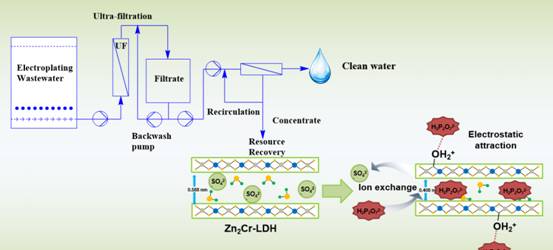近日,太阳官网付敦博士以第一作者在环境科学与工程领域国际期刊Chemosphere (中科院二区Top期刊;影响因子:5.778)上发表题为“Recovering heavy metals from liquid plating waste and their conversion into Zn2Crlayered double hydroxide (LDH) for pyrophosphate removal from contaminated wastewater”的研究论文,该研究工作得到了古天乐太阳娱乐集团tyc493博士科研启动基金(2019jb14)的资助与安徽省教育厅矿井水资源化利用重点实验室的平台支持。
摘要:This work incorporated technological values into Zn2Cr-layered double hydroxide (LDH), synthesized from unused resources, for removal of pyrophosphate (PP) in electroplating wastewater. To adopt a resource recovery for the remediation of the aquatic environment, the Zn2Cr-LDH was fabricated by co-precipitation from concentrated metals of plating waste that remained as industrial by-products from metal finishing processes. To examine its applicability for water treatment, batch experiments were conducted at optimum pH, dose, reaction time, and temperature. To understand the adsorption mechanisms of the PP by the adsorbent, the Zn2Cr-LDH was characterized using Brunauer-Emmett-Teller (BET), X-ray powder diffraction (XRD),Fourier-transform infrared spectroscopy (FT-IR), scanning electron microscopy/energy dispersive X-ray spectroscopy (SEM/EDS), and X-ray photoelectron spectroscopy (XPS) analyses before and after adsorption treatment. An almost complete PP removal was attained by the Zn2Cr-LDH at optimized conditions: 50 mg/L of PP, 1 g/L of adsorbent, pH 6, and 6 h of reaction. Ion exchange controlled the PP removal by the adsorbent at acidic conditions. The PP removal well fitted with a pseudo-second-order kinetics and the Langmuir isotherm model with 99 mg/g of PP adsorption capacity. The spent Zn2Cr-LDH was regenerated with NaOH with 86% of efficiency for the first cycle. The treated effluents could comply with the discharge limit of <1 mg/L. Overall, the use of Zn2Cr-LDH as a low-cost adsorbent for wastewater treatment has contributed to national policy that promotes a zero-waste approach for a circular economy (CE) through resource recovery paradigm.
